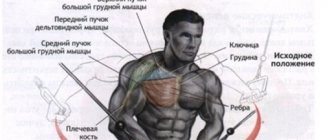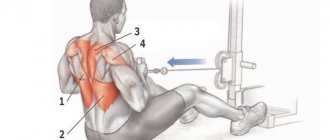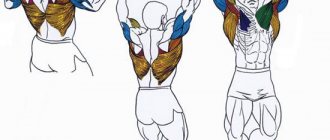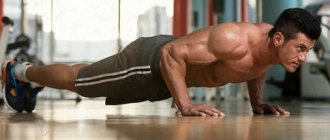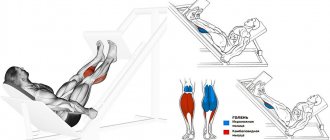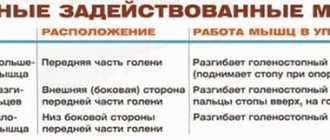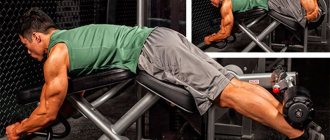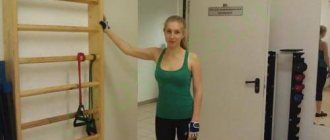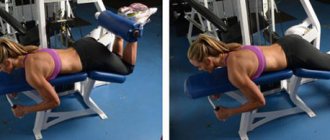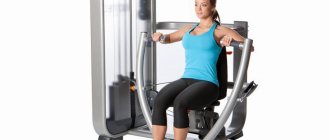What muscles work
In standing dumbbell biceps curls, the brachioradialis and brachialis muscles work the biceps brachii muscle (biceps) is included in the work Dumbbell curls for biceps are also performed in a sitting position, the technique does not change, the only thing is that the body on the vertical bench will be fixed and will not allow the body to sway. Both options can be performed with both hands or alternately.
Common mistakes
Movement of the body while bending the arms
. Indeed, this action helps the athlete bend his arms under the influence of heavy weight, but why do this if part of the load will go to the back muscles? The lat crossover curl is aimed at developing the biceps, so reducing the load may make this exercise less effective.
Excessive shoulder movements
. This mistake primarily concerns those athletes who are performing this exercise for the first time. Under the influence of the cables, the body begins to sway and the shoulder joints shift slightly. It is very important to keep them still as they can easily become dislocated under the weight.
Uneven execution
. Most people have uneven development of the right and left arms, so you want to pull the weight with your dominant arm, and only help a little with the other. In the future, this leads to the fact that the additional hand begins to lag behind, and the main one, on the contrary, develops too much. To prevent this from happening, it is recommended to slightly weaken your dominant hand.
Alternate arm row
. Some athletes mistakenly believe that alternating arm rows will help build better biceps. This is not entirely true, because the right hand (for right-handed people) will constantly pull harder and will therefore develop better. In addition, performing this exercise is fraught with curvature of the spine.
Technique: lifting dumbbells for biceps
- Standing or sitting, legs are shoulder-width apart. We hold dumbbells in our hands, placing them on the sides near the hips.
- Exhale: bend one arm at the elbow, working through the biceps.
- Inhale: Extend your elbow three times slower than bending, smoothly performing the movement.
Perform the same number of times on each hand. It is optimal to do 3–4 approaches, depending on the level of physical fitness and working weight, 8–12 repetitions.
Correct technique
- To perform this exercise, the lifter will need to attach D-handles to both cables that run through the top pulleys of the machine. The handles should be grasped with an overhand grip, that is, the palms should be facing upward. After this, you need to stand in the middle of the racks of the simulator.
- In the starting position, the arms are fully straightened or remain slightly bent at the elbow joints. However, in any case, the hands go straight to the blocks. They should be in line with the cables that lift the weight from the machine's supports.
- When inhaling, the athlete holds his breath. The biceps tenses as much as possible, the elbows bend and the handles begin to be pulled toward the head.
- When your palms are above the deltoid muscles, you need to stop for a few seconds. After this, the biceps tighten even more.
- Exhaling, the athlete lowers the handles to their original position. This movement is done smoothly.
- The required number of repetitions is performed. On average, it is recommended to do 10 to 15 repetitions in 3 sets. But don't overestimate your strength.
Incline dumbbell curls for biceps
An excellent alternative to classic lifts, which is performed lying on a bench at an angle of 45 degrees. With this option, the biceps receives an isolated load at the top point when the hands are supinated. The shoulder and brachioradialis also work.
In this option, it is impossible to perform cheating - swinging the body, and perform bending by inertia.
- Set the bench at an angle of 45 degrees, hold dumbbells in your hands and sit on the bench, lower yourself onto your back.
- Hands in a hanging position under the bench.
- Keep your head up while watching the movement of your arms. For pain in the shoulder joints, perform the option on a bench while sitting at an angle of 90 degrees.
- Exhale: first, bend with one arm; in the middle of the movement, turn the hand toward the shoulder, contracting the biceps as much as possible in the upper phase.
- Inhale: Gently lower your arm without throwing it down, keeping your elbow slightly bent to prevent sprain.
- After full extension, repeat the same movement with your other arm.
Perform 8-12 times on each side alternately, and also 3-4 approaches.
Read about how to perform all variations of supination curls →
The most common mistakes when training biceps
Some athletes find it quite difficult to perform this movement with full amplitude.
As a result, they do not fully extend their arms in the lower position of the trajectory; this is a rather serious mistake, since it does not allow maximum load on the target muscle. If a large weight is used, the athlete's body may begin to sway, which as a result significantly reduces the load on the biceps. Try to keep your body level or perform the movement on a bench. Only a slight tilt of the body back is allowed, but not to the sides or forward.
If, when performing other movements on the biceps, when performing curls on the block, the elbow joints remain mobile. At the same time, they should not swing, and only a slight extension forward in the upper extreme position is allowed. It is also necessary to ensure that the exercise is performed with muscle strength, and not due to the movement of the hands.
As with any movement, you need to be careful with your technique. Of course, this primarily concerns beginners, who often rush to progress the load without fully mastering the movement. You must understand that only a technically correctly performed movement can benefit you. Moreover, if you violate the technique and use heavy weights, the likelihood of injury will increase dramatically. Only by performing the biceps movement on the block technically competently can you get the desired result.
Check out the technique of training biceps on a block machine in this video:
Greetings, dear comrades! And today we’ll talk about overhead biceps curls on the upper block.
Wednesday on the calendar 18
October, which means it's time for a technical note on . After reading, you will learn everything about the muscle atlas, the advantages and technique of performing the exercise, we will also find out the degree of its effectiveness and the advisability of including it in the training program.
So, take your seats in the auditorium, we are starting.
Dumbbell Concentration Curls
Another great exercise for isolated biceps work. In a sitting position, first bend with dumbbells with one hand, then change to the other. Its essence is that the elbow is pressed against the inner surface of the shoulder, and it will be impossible to perform a jerk. In this case, you won't need a lot of dumbbell weight.
Read more about concentrated biceps curls here →
Legs and buttocks
Although exercises with a barbell are considered preferable for the muscles of the legs and buttocks (due to the ability to introduce huge weights), however, with the help of dumbbells, these muscle groups can also develop absolutely perfectly. To get what you want, the main thing is that the exercises are performed according to the rules.
All movements must be clear and precise. And as a result, in addition to noticeable visible changes, you will get strong legs and buttocks, which will allow you to significantly improve your performance in other sports, such as running and jumping.
Deadlift with dumbbells
In this exercise, the buttocks, thigh muscles and lower back receive the greatest load. The arms are in a better position during dumbbell rows than with a fixed barbell bar.
Thanks to this position of the hands, the center of gravity can be moved, as a result of which the load on the back extensors is reduced, and the load on the back of the leg becomes more concentrated.
To do this exercise, grab dumbbells and stand up straight. Feet at shoulder width. As you inhale, move your pelvis back, lean forward, and slowly lower the dumbbells down. Exhale, return to the starting position.
Squat with dumbbells
Squats are the main exercise for strengthening the front and back muscles of the thighs and buttocks. The muscles of the inner and outer thighs are used at the same time. To perform this exercise, grab a dumbbell and stand up straight.
The legs are widened at the level of the shoulders, the toes are slightly apart. Hands with dumbbells are located along the body, palms facing inward. Keeping your pelvis in a neutral position, straighten your chest. Inhale, hold your breath, stomach drawn in. Do a squat as if you want to sit on the edge of a chair.
Don't lift your heels off the floor. Lower yourself until your upper legs are parallel to the floor. Return to the starting position. At the moment of greatest effort, exhale.
Lunges with weights
Lunges with a shell are one of the best exercises for strengthening the muscles of the legs and buttocks. In this exercise, the biceps femoris and gluteal muscles are heavily loaded. To do this, lift the dumbbells and stand straight. Place your feet shoulder-width apart.
Bring your shoulder blades together, lower your shoulders, tone your abs. Hands with dumbbells are lowered along the body, palms pointing inward. Take an extended step forward with your left foot and dive long so that your left knee is above your ankle and your right knee is facing the floor.
The right leg is resting with the toe on the floor. Straighten your legs and take a step forward with your right foot. Continue mixing your legs as many times as you like.
Dumbbell curls on a Scott bench
On the L. Scott bench, you can qualitatively work out the biceps brachii muscle, similar to concentrated lifts, or bending on an inclined bench, the muscle is completely isolated . With this technique, the elbows rest on a special board of the Scott bench, and simultaneous or alternate bending with dumbbells is performed. When lifting one dumbbell, you can use your other free hand to help your biceps complete the last reps to failure by slightly pushing your forearm.
How to properly work on a Scott bench is written in this article →
Hammer Dumbbell Curl
The hammer grip can be performed both standing and sitting. The technique eliminates supination ; the hands and forearms do not rotate, which increases the load on the brachioradialis muscle. Therefore, this technique is also used to work out the forearms. The “hammer” can be performed either simultaneously with both hands or alternately.
You can familiarize yourself with the “Hammer” exercise technique at this link→
Triceps exercises
The triceps (triceps brachii muscle) is responsible for straightening the elbow (straightening the arms). Decent arm development is the biceps and triceps. Therefore, the triceps should be prepared and developed as actively as the biceps. Let's take a look at how you can improve your triceps at home with a few handy dumbbells.
- Movement of the dumbbell up and down from behind the head with one hand . Stretching your arm with a dumbbell behind your head is perhaps the most popular exercise at home. Stand up straight with dumbbells in one hand. Raise your hand, at this time place your free hand on your belt, lower it down or “hug” yourself (like Arnie on the left). Rotate the dumbbell forward. Start by slightly curling your arm, moving the dumbbell behind your head. The shoulder part does not move, only the forearm works. After you have stretched your triceps well, pause in this position and carefully raise your arm. Repeat the exercise. The dumbbell overhead press can be performed either standing or sitting.
- Move the dumbbell up and down from behind your head with both hands. Before performing a bench press, test the apparatus for resistance. If the dumbbell is heavy (15-20 kg or more), use a sports belt. Grasp the dumbbell plate with both hands. For safety, grab the bar with your thumbs. Stand straight with your legs wide apart (you can do the exercise while sitting). Raise the dumbbell above your head. Now smoothly move your hands behind your head, bending them at the elbows (just don’t pull them in different directions). Do you feel a stretch in your triceps? Extend your arms using your triceps, take your time. Repeat the exercise.
- French press with dumbbells. Lie on a bench or on the floor. The head and legs are pressed tightly together. Stretch your arms with dumbbells up (parallel to each other) and slightly tilt them towards your head. Inhale: Bend your arms smoothly and gently (don't hit) lower the dumbbells until they are on either side of your head. During this time, the elbows are fixed in one position. Exhale: actively extend your arms. In the upper position, freeze for a split second and repeat as many times as necessary. During the exercise, watch your elbows - they should be practically motionless. We recommend using this weight so that you can do about 10 reps without any difficulty.
- Bent over arm stretching with dumbbells back . Stand up, put your feet in a firm position, bend your knees slightly and lean forward. The back is straight. Place your free hand on your knees and bend your working arm at a 90° angle, bringing it closer to your body. Inhale and straighten your arm back, extending it. At the end of the movement, exhale. This exercise is great for strengthening your triceps.
Recommendations: how to properly lift dumbbells for biceps
A huge variety of techniques and options for biceps exercises allows you to choose your own technique for high-quality biceps work without injury, taking into account the individual characteristics of the joints. But don’t get hung up on one option, change sets of exercises, changing grips, equipment, adding the number of exercises to avoid stagnation in progress. It is important that the effortful movement when lifting dumbbells must be performed while exhaling. Moreover, the movement should be quite fast, but not jerky. And the relaxation phase should last three times longer, and must be performed while inhaling. Between approaches, wait 1-2 minutes to recover, do not overload the muscles , otherwise you will get the opposite effect.
